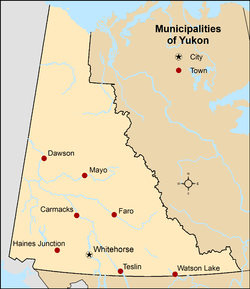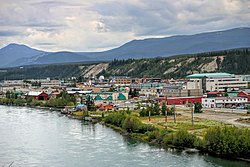List of municipalities in Yukon




Yukon is the second most populous of Canada's three territories with 40,232 residents as of 2021.[1] It is the smallest territory in land area at 472,345 km2 (182,373 sq mi).[2] Yukon's eight municipalities cover only 0.2% of the territory's land mass[a] but are home to 72.2% of its population.[1][2][4] The remainder of the territory's land area is unorganized.
Municipal governments are created by the Government of Yukon in accordance with the Municipal Act of 2001.[5] Municipal governments provide "jurisdiction services, facilities, or things that a local government considers necessary or desirable for all or part of its community".[5] Classifications of municipalities under the Municipal Act include cities and towns.[5] Whitehorse is the capital of Yukon and its only city. The remaining seven municipalities are towns, of which four were villages that were continued as towns upon adoption of the 2001 Municipal Act.[5]
Over two-thirds of the population of Yukon (28,201 residents; 70.1%) reside in Whitehorse, the largest municipality in the territory.[1] It is also the largest municipality by land area at 413.94 km2 (159.82 sq mi).[1] The smallest municipality by population and land area is Mayo, with 188 residents in 0.98 km2 (0.38 sq mi).[1]
Cities
[edit]A proposal to incorporate a community as a city can be initiated under the Municipal Act at the request of Yukon's Minister of Community Services, a municipal council, or a minimum 30% of residents that are eligible electors if the community has an estimated population over 2,500.[5] Cities must elect a mayor and six councillors (in the case of Whitehorse), or a mayor and eight councillors if authorized by bylaw, for a three-year term.[5] The only city in Yukon is Whitehorse, which is the largest of the three cities in Northern Canada's three territories. It had a population of 28,201 residents and a land area of 413.94 km2 (159.82 sq mi) in the 2021 Census.[1] The City of Dawson is a former city in Yukon that now has town status but is permitted to retain "city" in its official name.[5]
Towns
[edit]A proposal to incorporate a community as a town can be initiated under the Municipal Act at the request of the Minister of Community Services, a municipal council, or a minimum 30% of residents that are eligible electors if the community has an estimated population over 300.[5] Towns must elect a mayor and four councilors, or a mayor and five to seven councillors if authorized by bylaw, for a three-year term.[5]
All municipalities that were villages prior to the adoption of the 2001 Municipal Act were continued as towns but were permitted to retain "village" in their official names.[5] Yukon has seven towns. Dawson City is the territory's largest town by population with 1,577 residents and Faro is the largest by land area 199.89 km2 (77.18 sq mi).[1] Mayo is the smallest town by population and land area at 188 residents in 1.06 km2 (0.41 sq mi).[1]
List of municipalities
[edit]| Name | Status[4] | Official name | Incorporation date[6] | 2021 Census of Population[1] | ||||
|---|---|---|---|---|---|---|---|---|
| Population (2021) | Population (2016) | Change | Land area (km2) | Population density (/km2) | ||||
| Carmacks | Town | Village of Carmacks | November 1, 1984 | 588 | 493 | +19.3% | 36.87 | 15.9 |
| Dawson | Town | City of Dawson[b] | January 9, 1902 | 1,577 | 1,375 | +14.7% | 30.91 | 51.0 |
| Faro | Town | Town of Faro | June 13, 1969 | 440 | 348 | +26.4% | 199.89 | 2.2 |
| Haines Junction | Town | Village of Haines Junction | October 1, 1984 | 688 | 613 | +12.2% | 34.30 | 20.1 |
| Mayo | Town | Village of Mayo | June 1, 1984 | 188 | 200 | −6.0% | 0.98 | 191.8 |
| Teslin | Town | Village of Teslin | August 1, 1984 | 239 | 255 | −6.3% | 3.77 | 63.4 |
| Watson Lake | Town | Town of Watson Lake | April 1, 1984 | 1,133 | 1,083 | +4.6% | 109.77 | 10.3 |
| Whitehorse | City | City of Whitehorse | June 1, 1950 | 28,201 | 25,085 | +12.4% | 413.94 | 68.1 |
| Total municipalities | 33,054 | 29,452 | +12.2% | 830.43 | 39.8 | |||
| Yukon | 40,232 | 35,874 | +12.1% | 472,345.44 | 0.1 | |||
See also
[edit]Notes
[edit]- ^ The remaining 99.8% of Yukon's land mass comprises two unincorporated hamlets, four unorganized areas, four Indian settlements, four self-governments (Indian reserves), thirteen unincorporated settlements and a Teslin land claim.[3] Unorganized Yukon, one of the four unorganized areas, accounts for the vast majority of the territory's land mass, at 98.1%.[1]
- ^ As of the 2001 Municipal Act, the town's official legal name is the "City of Dawson".[5]
References
[edit]- ^ a b c d e f g h i j "Population and dwelling counts: Canada, provinces and territories, and census subdivisions (municipalities), Yukon". Statistics Canada. February 9, 2022. Retrieved February 18, 2022.
- ^ a b "Population and dwelling counts, for Canada, provinces and territories, 2021 and 2016 censuses – 100% data". Statistics Canada. March 14, 2022. Retrieved March 14, 2022.
- ^ "Interim List of Changes to Municipal Boundaries, Status, and Names: From January 2, 2012 to January 1, 2013" (PDF). Statistics Canada. pp. 6–7. Retrieved August 19, 2014.
- ^ a b "Yukon Communities". Yukon Government: Department of Community Services. November 7, 2013. Archived from the original on January 16, 2014. Retrieved January 15, 2014.
- ^ a b c d e f g h i j k "Municipal Act" (PDF). Government of Yukon. 2002. Retrieved January 6, 2014.
- ^ "Association of Yukon Communities Incorporation Dates". Association of Yukon Communities. Archived from the original on June 15, 2014. Retrieved June 14, 2014.
External links
[edit]


 French
French Deutsch
Deutsch